Table of Contents
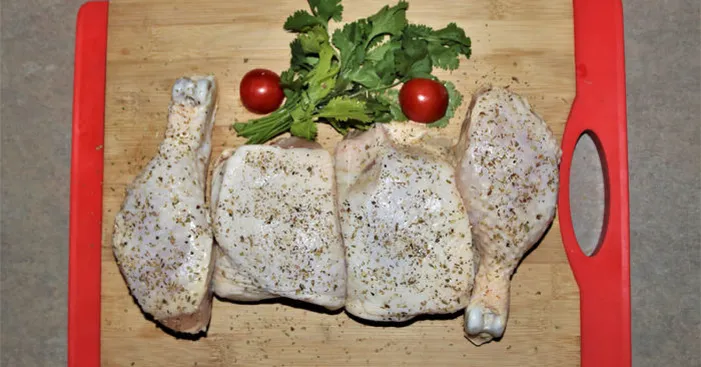
Chicken is a staple in many people’s diets, and for good reason.
Not only is it a versatile protein that can be cooked in a variety of ways, it also has a range of nutritional benefits.
However, when it comes to chicken, not all body parts are created equal.
Different cuts of chicken have different nutritional values and benefits.
In this blog post, we’ll take a closer look at the nutritional breakdown of various chicken body parts, including the breast, thigh, drumstick, wing, and more.
We’ll explore the differences in protein, fat, and other essential nutrients, as well as the unique benefits of each cut.
Whether you’re trying to build muscle, lose weight, or just eat a well-rounded diet, understanding the nutritional value of different chicken body parts can help you make more informed choices about what to put on your plate.
Is chicken good for you?
As I always try to be as honest and subjective as I can be, chicken is good for you but it can also be bad!
It all comes down to the ratio of amounts of calories consumed vs the number of calories burned.
Red meat is loaded with saturated fat in many of its cuts.
Usually, this shouldn’t be a problem.
But eating red meat on a daily basis would be problematic, as it offers a high caloric content that can lead to health problems.
On the other hand, chicken doesn’t have as much saturated fat, at least in their lean cuts like chicken breast, which makes it a healthy source of protein.
In other words, chicken is good for you as long as you are burning calories as much as you consume it!
Cutting a chicken into body parts:

There is no right or wrong when it comes to cutting a chicken, however, it seems that some cuts can be distinguished.
Depending on the type of meat, you can cut your chicken into dark meat and white meat cuts and each of those have a different flavor.
Breast meat is white, lean, drier and a better choice health-wise.
On the other hand, chicken legs are dark meat with a more pronounced flavor and they are slightly less healthy than breast meat.
Also, the wings of a chicken are the most flavorful parts, however, they are the least healthy as they contain a lot of fat.
Steps to cut a whole chicken into body parts:
- Start by slightly stretching the chicken by pulling the legs and wings in a different direction.
- Place the chicken on its back, and cut it in halves starting from the bottom of the breast until you reach the neck, and doing the same on the other side.
- Cut the neck off then make sure you cut right through the ribcage to obtain identical chicken halves.
- You may need to use some muscles to break open the chicken ribcage in halves after you cut all the meat.
- Take half of the chicken, pull one leg up and cut it down to its joint.
- You don’t have to cut through the bone, just cut straight into the joint, and that will do.
- Repeat the same process for the other leg, then cut the legs joints to separate drumsticks from thighs.
- Now you are left with two upper halves each containing a wing and a side breast.
- Pull the wing up and also cut through the joint by pointing the tip of the knife right into the joint it should come out easily.
- Repeat the same process for the other wing,
- Cut each chicken breast off from the backside that is attached to it.
As a result, you will obtain 2 chicken breasts, 2 wings, 2 thighs, 2 drumsticks. (1)
In addition, you will have the neck and the two sides of the chicken back+rib cage which you can use in your stew recipes.
Chicken body parts:
Chicken breast nutrition:

With the least amount of calories and fat, chicken breast is the true definition of white meat.
It is among the healthiest parts of a chicken. It is also the most expensive cut compared to other cuts.
Chicken breast is the part with the most meat in a chicken, although most people don’t consider it as flavorful as the other cuts.
Raw chicken breast nutrition:
One thing you can put in mind is, the calories in a chicken breast follow the 80-20 rule and that is 80% coming from protein and 20 % from fat!
Of course, it also contains calcium, potassium, cholesterol, and sodium.
Now we all know chicken breasts can vary in size, so the following values are based on a medium-sized skin and bone-in chicken breast of 3.5 oz (100 grams) :
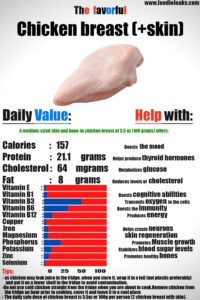
- Calories: 157
- Protein: 21.1g
- Cholesterol: 64mg
- Fat: 8g
- E vitamin: 3%
- B1 vitamin: 5%
- B3 vitamin: 60%
- B6 vitamin: 38%
- B12 vitamin: 13%
- Copper: 4%
- Iron: 7%
- Magnesium: 7%
- Phosphorus: 27%
- Potassium: 12%
- Zinc: 8%
- Calcium: 2%
These nutritional values count for a raw chicken breast. (2)
Once the chicken breast gets cooked, whether in oil or you add other ingredients to it, the number of calories will increase.
Boiling food, as well as grilled, does not necessarily require added butter or oil which makes these cooking methods better than the other ones.
Boneless skinless chicken breast calories:
Do you want to eat healthily?
You want to build up muscles and do it like a pro!?
If so, then this information should be of great use to you:
3.5oz (100g) of boneless skinless chicken breast boiled or grilled should provide you with: (3)
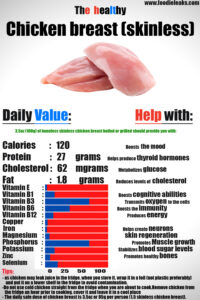
- Calories: 120
- Protein: 27g
- Cholesterol: 62mg
- Fat: 1.8g
- E vitamin: 3%
- B1 vitamin: 15%
- B3 vitamin: 70%
- B6 vitamin: 39%
- B12 vitamin: 13%
- Copper: 4%
- Iron: 3%
- Magnesium: 7%
- Phosphorus: 70%
- Potassium: 15%
- Zinc: 8%
- Selenium: 20%
Chicken wing nutrition:
Unlike other parts of the chicken, wings are the tenderest part.
They don’t have a lot of meat since the bird doesn’t fly and they’re not used that much.
Hence, chickens didn’t build up muscles in their wings and that explains why wings are soft, as they are mainly skin with little meat in them.
Like every other part, chicken wings vary in size depending on the bird.
This information is for an average-sized chicken wing skin-in and bone-in that weight about 3.5 oz (100g) : (4)
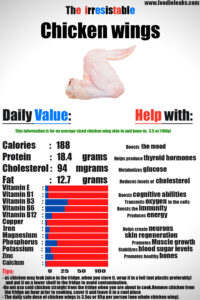
- Calories: 188
- Protein: 18.4g
- Cholesterol: 94mg
- Fat: 12.7g
- E vitamin: 5%
- B1 vitamin: 5%
- B3 vitamin: 36%
- B6 vitamin: 31%
- B12 vitamin: 11%
- Copper: 3%
- Iron: 7%
- Magnesium: 5%
- Phosphorus: 19%
- Potassium: 9%
- Zinc: 13%
- Calcium: 2%
Are chicken wings healthy?

Let’s talk about chicken wings!
They are one of the most well-known parts of the chicken.
But are chicken wings healthy?
Since chickens don’t fly, their wings did not develop many muscles.
Chicken wings are mainly made of sinew, tendons, bone, and skin with not much muscle.
Most people who like chicken wings choose them because of the juicy aspect.
This is caused by the high percentage of fat found in the layers underneath the skin.
As for their health impact on our body, it depends mainly on how they are prepared.
It is recommended to remove the skin before cooking.
With that being said, chicken wings are very healthy as long as you remove their skin before cooking, and eating them 2 to 3 times a week will provide very useful nutrients and vitamins for your body.
There are many more benefits we will see in the upcoming sections of this article.
Chicken drumstick nutrition:
the legs of a chicken can be cut into two different parts, the upper part and which is the thigh, and the lower part and that is called: the drumstick!
A chicken drumstick is considered dark meat!
That makes it more flavorful than a chicken breast but also slightly higher in calories.
Drumstick caloric value follows the 70-30 rule, with 70% coming from protein and 30% from fat.
3.5 oz (100g) of drumstick with skins and bones offers:
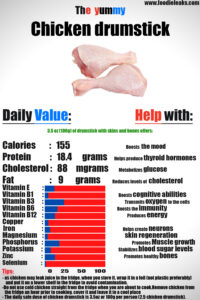
- Calories: 155
- Protein: 18.4g
- Cholesterol: 88mg
- Fat: 9g
- D vitamin: 16%
- B1 vitamin: 6%
- B3 vitamin: 32%
- B6 vitamin: 21%
- B12 vitamin: 17%
- Copper: 6%
- Iron: 9%
- Magnesium: 5%
- Phosphorus: 24%
- Potassium: 10%
- Zinc: 17%
- Calcium: 2%
we can clearly see that, for the same serving size, drumsticks are higher in fat and lower in protein compared to chicken breast. (5)
Chicken thigh nutrition:
Twin sister of drumstick, chicken thigh is the lower part of the leg.
They are also considered dark meat, definitely more flavor but less protein and more fat come in it.
3.5 oz (100g) of raw chicken thighs with skin and bones offers:

- Calories: 191
- Protein: 25g
- Cholesterol: 133mg
- Fat: 9.6g
- D vitamin: 10%
- B1 vitamin: 5%
- B3 vitamin: 31%
- B6 vitamin: 14%
- B12 vitamin: 20%
- Copper: 10%
- Iron: 9%
- Magnesium: 7%
- Phosphorus: 23%
- Potassium: 13%
- Zinc: 24%
- Calcium: 2%
As you can see, the fat is higher than both chicken breast and drumstick. (6)
That is because the chicken thigh calorie count is almost 50-50 with 50% coming from protein and 50% coming from fat.
Chicken leg nutrition:
the chicken leg is basically dark meat, rich in flavor with more fat than chicken breast.
As mentioned above, it is a combination of a thigh and a drumstick!
A typical whole chicken leg skin-in and bone-in, the drumstick is 44g and the thigh is (52g) and that provides: (7)
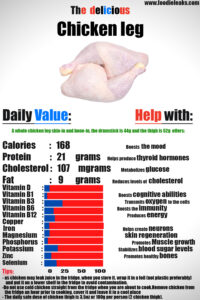
- Calories: 168
- Protein: 21g
- Cholesterol: 107mg
- Fat: 9g
- D vitamin: 9%
- B1 vitamin: 5%
- B3 vitamin: 31%
- B6 vitamin: 16%
- B12 vitamin: 18%
- Copper: 8.5%
- Iron: 9%
- Magnesium: 6%
- Phosphorus: 23%
- Potassium: 12%
- Zinc: 21%
Pretty filling right!! Don’t forget the part that is responsible for the most fat is the skin.
Without skin, a whole chicken leg (drumstick + thigh) with the same serving size as above would be 380 calories instead of 558 calories!
chicken benefits:
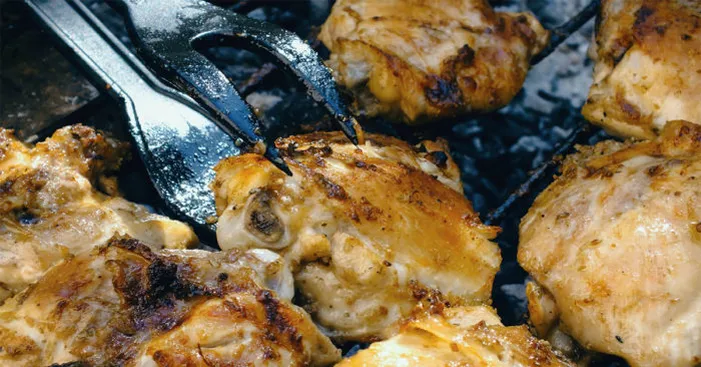
Not only cheaper than other types of meat, but chicken is also rich in minerals, proteins, and vitamins.
Minerals in chicken body parts:
chicken is white meat (with some dark meat) that is rich in minerals.
Phosphorus:
white meat is full of phosphorus, which contributes to bones and teeth health, skin regeneration, and control PH level in the blood. (8)
Zinc:
Chicken contains zinc, it is more present in the dark meat parts (chicken breast), we can also find it in the white parts of the bird.
Zinc is essential for a good functioning immune system and a well-balanced thyroid, sexual and pancreatic (mostly insulin) hormones. (9)
Selenium:
Chicken is a good source of selenium.
This mineral plays a crucial role in fighting oxidation, it may also help prevent chronic diseases including cancer.
In addition to that, selenium participates in the formation of thyroid hormones. (10)
Chicken provides many other minerals including Iron (easier to dissolve compared to vegetable iron), Magnesium, Potassium, and copper.
Vitamins in chicken body parts:
Chicken contains a lot of vitamins including B3, B6, B1, B2, B5, and B12.
Here are the health benefits of some of those vitamins:
Vitamin B3:
This vitamin is necessary for the creation of blood, neurons, and sexual hormones.
It plays a huge role in glucose metabolism.
B3 can remarkably reduce levels of cholesterol in the blood.
In addition to that, this vitamin also helps transmit oxygen to the cells. (11)
Vitamin B6:
Chicken is so rich in B6, it’s a coenzyme that helps break protein and saturated fat.
Just like B3, vitamin B6 also helps in the creation of blood and neurotransmitters.
It was proven that B6 contributes to the well-functioning of our immunity system. (12)
Vitamin B2:
This vitamin found in chicken is necessary for the cells as it helps them produce energy. (13)
This vitamin helps with skin regeneration and as a result, prevents wrinkles and stretch marks.
Vitamin B5:
Just like its fellow vitamins in the B group, this vitamin helps in many processes including, blood creation, neurotransmitters production, and some hormones.
Protein in a chicken:
Probably the most known fact about chicken: they are full of protein!
That is so right!! In fact, the protein found in chicken is on top of the list of complete protein sources.
Eating chicken more often will help you lose weight or maintain it, generate muscles, strengthen bones health, and boost your energy levels.
There is a long list of the effect of protein in the body, here are some of the benefits you get from chicken protein:
Muscle creation:
You could be working out daily and not see significant changes to your body, you want those abs to kick in and those biceps to grow bigger…
You are giving every last drop of sweat but still, not many results are shown?
It’s because our bodies are more affected by what we eat instead of how much exercise we do!
In other words, nutrition makes 80% of our body shape when only 20% are affected by workouts!
Well, let’s not take away the benefits of working out, they are essential for a muscular figure.
Our bodies need nutrients to help build those muscles bigger, those nutrients are essentially the 9 amino acids found in chicken protein.
Other meat sources can lack one of the 9 amino acids, but with chicken, you’ll get all of the 9 amino acids needed to build your muscles, or even just maintain your body weight. (14)
Stability of blood-sugar levels:
Basically, protein slows down the absorption of sugar which prevents hyperglycemia, and that is the increase of blood sugar level.
This may help with type 2 diabetes, diversify your food diet and balance your energy levels. (15)
Bones health:
Protein in chicken is rich in calcium and magnesium, which are essential nutrients for bone building.
This can help prevent fractures or bone weakness, and heal broken bones faster. (16)
Raise concentration levels:
One of the many brain nutrients is amino acids.
They are necessary to maintain focus or concentration levels.
If your brain does not get the number of amino acids it needs, it can result in learning problems and bad coordination.
As mentioned above, protein in chicken is a complete source of amino acids. (17)
May slow down aging:
In the detoxification process, our bodies use protein to help synthesize Glutathione (GSH) which results in reducing carcinogens, the main responsible components for aging. (18)
Glutathione (GSH) is also recommended to fight Parkinson’s, Alzheimer’s, cell anemia, liver disease, and viral infections.
Boost the mood:
Eating chicken more often will supply your body with protein. (19)
As protein contains all the amino acids, your body uses an amino acid called tryptophan to balance hormones and give you a sense of comfort.
Another amino acid found in protein is serotonin.
This amino acid is essential in boosting mood.
Tips:
- As chicken may leak juice in the fridge, when you store it, wrap it in a foil (not plastic preferably) and put it on a lower shelf in the fridge to avoid contamination.
- Do not use cold chicken straight from the fridge when you are about to cook.
Remove chicken from the fridge an hour before cooking, cover it and leave it in a cool place (not necessarily warm). - Make sure the oven is preheated to the correct temperature before putting the chicken in.
References:
(1): How to cut a whole chicken step by step – Feast and Farm
(2):FoodData Central (usda.gov)
(3): Nutrition Facts – Chicken & Turkey (usda.gov)
(4): Nutrition Facts – Chicken & Turkey (usda.gov)
(5): Nutrition Facts – Chicken & Turkey (usda.gov)
(6): Nutrition Facts – Chicken & Turkey (usda.gov)
(7): Nutrition Facts – Chicken & Turkey (usda.gov)
(8): Health benefits of phosphorus in your diet (medicalnewstoday.com)
(9): What Are the Potential Benefits of Zinc Supplements? | Everyday Health
(10): Role of Organic Selenium in poultry feed – Orffa
(11): Effect of Dietary Niacin Supplementation on Growth Performance, Nutrient Digestibility, Hematology, and Lipoprotein Concentrations of Young Turkeys, Meleagris gallopavo (nih.gov)
(12): 9 Health Benefits of Vitamin B6 (Pyridoxine) (healthline.com)
(13): Vitamin B2 (Riboflavin) Information | Mount Sinai – New York
(14): Poultry Meat Quality in Relation to Muscle Growth and Muscle Fiber Characteristics (nih.gov)
(15): Red meat and chicken consumption and its association with high blood pressure and obesity in South Korean children and adolescents: a cross-sectional analysis of KSHES, 2011–2015 (nih.gov)
(16): Protein intake and bone health – PubMed (nih.gov)
(17): Effectiveness of Essence of Chicken on Cognitive Function Improvement: A Randomized Controlled Clinical Trial (nih.gov)
(18): Application of Glutathione as Anti-Oxidative and Anti-Aging Drugs – PubMed (nih.gov)
(19): The Effect of Chicken Extract on Mood, Cognition and Heart Rate Variability (nih.gov)
